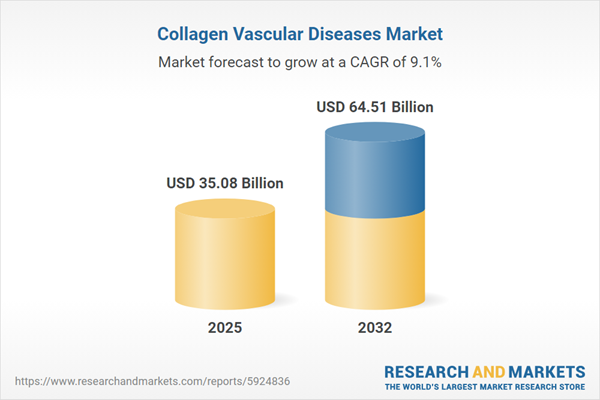Speak directly to the analyst to clarify any post sales queries you may have.
The market for collagen vascular diseases is evolving rapidly, shaped by advances in clinical research, complex immunopathology, and shifting regulatory and economic landscapes. This report provides senior decision-makers with critical, actionable insights to steer strategic planning, market entry, and innovation initiatives within this dynamic sector.
Market Snapshot: Collagen Vascular Diseases Market Overview
The Collagen Vascular Diseases Market grew from USD 32.21 billion in 2024 to USD 35.08 billion in 2025. It is expected to continue growing at a CAGR of 9.06%, reaching USD 64.51 billion by 2032. This substantial expansion reflects heightened diagnostic rates, significant unmet clinical needs, and growing adoption of advanced therapies and digital health tools globally. Stakeholders are responding with innovative treatment paradigms, data-driven strategies, and adaptive manufacturing to capture growth and alleviate patient burden.
Scope & Segmentation: In-Depth Industry Coverage
- Disease Indication: Covers dermatomyositis, rheumatoid arthritis, Sjogren's syndrome, systemic lupus erythematosus, systemic sclerosis, and vasculitis types including large vessel (giant cell arteritis, Takayasu's arteritis), medium vessel (Kawasaki disease, polyarteritis nodosa), and small vessel categories (ANCA associated vasculitis, cryoglobulinemic vasculitis, IgA vasculitis).
- Therapy Type: Includes biologics (anti-TNF agents, B cell depleting therapies, fusion proteins, interleukin inhibitors), immunosuppressants, small molecule drugs, and steroids.
- End User: Analyzes clinics, hospitals, and research institutes involved in disease management and clinical trials.
- Route of Administration: Examines injectable, oral, and topical delivery methods impacting therapy accessibility and adherence.
- Distribution Channel: Assesses hospital pharmacies, online pharmacies, and retail pharmacies shaping product availability.
- Regions: Explores market dynamics and trends across Americas (including North America and key Latin American markets), Europe, the Middle East, Africa, and Asia-Pacific.
- Leading Companies: Profiles strategic activities and innovation by organizations such as AbbVie Inc., Roche Holding AG, Novartis AG, Johnson & Johnson, Pfizer Inc., Bristol-Myers Squibb Company, Eli Lilly and Company, GlaxoSmithKline plc, UCB S.A., and Sanofi S.A.
Key Takeaways for Decision-Makers
- Research investments and clinical progress are focused on moving beyond broad-spectrum immunosuppression toward precision-based interventions, utilizing immune checkpoint and cytokine modulation technologies.
- Digital health and telemedicine solutions, including remote symptom tracking and virtual care, are strengthening patient engagement and enhancing real-world data collection for adaptive trial designs.
- Collaborative consortia between biopharma, academic centers, and advocacy groups are standardizing biomarker discovery and harmonizing clinical protocols to accelerate therapy development and approval processes.
- Manufacturers are reengineering supply chains and production models in response to evolving reimbursement strategies, import duties, and local manufacturing incentives, which impact operational continuity.
- Segmentation by pathology and therapy type is enabling more personalized market approaches, supporting stratified patient management and targeted clinical development for niche subgroups.
- Regional disparities in healthcare infrastructure and regulatory frameworks demand tailored go-to-market approaches to optimize access and address diverse patient populations.
Tariff Impact & Response Strategies
Recent changes in United States tariff regulations have increased costs for pharmaceutical ingredients and raw materials, prompting a strategic reevaluation of supplier networks, inventory practices, and contractual terms. Organizations are accelerating domestic manufacturing investments to safeguard supply chain resilience and mitigate geopolitical risks, while also adapting pricing and market access models through value-based agreements and risk-sharing arrangements. Research partnerships are increasingly shaped by these tariff shifts, distributing financial risk and leveraging locations with favorable trade climates to sustain R&D progress.
Methodology & Data Sources
This report employs a rigorous blend of qualitative and quantitative research. Findings are underpinned by extensive reviews of clinical studies, regulatory publications, and sector data, as well as primary interviews with KOLs, investigators, and industry leaders. Regional validation and scenario analyses further ensure accuracy, minimize bias, and capture market-relevant nuances.
Why This Report Matters for Senior Leaders
- Supports robust market entry, expansion, and innovation decisions through actionable segmentation, regulatory, and tariff insights.
- Helps optimize resource allocation by spotlighting high-potential therapy areas and emerging patient cohorts within the global collagen vascular diseases landscape.
- Enables proactive supply chain and partner strategies in line with evolving policy and infrastructure challenges.
Conclusion
The collagen vascular diseases market is defined by its complexity and pace of innovation. Leaders equipped with this detailed report are well-positioned to capitalize on emerging opportunities, navigate risks, and advance patient-centric outcomes in an evolving therapeutic landscape.
Additional Product Information:
- Purchase of this report includes 1 year online access with quarterly updates.
- This report can be updated on request. Please contact our Customer Experience team using the Ask a Question widget on our website.
Table of Contents
3. Executive Summary
4. Market Overview
7. Cumulative Impact of Artificial Intelligence 2025
Companies Mentioned
The companies profiled in this Collagen Vascular Diseases market report include:- AbbVie Inc.
- Roche Holding AG
- Novartis AG
- Johnson & Johnson
- Pfizer Inc.
- Bristol-Myers Squibb Company
- Eli Lilly and Company
- GlaxoSmithKline plc
- UCB S.A.
- Sanofi S.A.
Table Information
| Report Attribute | Details |
|---|---|
| No. of Pages | 199 |
| Published | November 2025 |
| Forecast Period | 2025 - 2032 |
| Estimated Market Value ( USD | $ 35.08 Billion |
| Forecasted Market Value ( USD | $ 64.51 Billion |
| Compound Annual Growth Rate | 9.0% |
| Regions Covered | Global |
| No. of Companies Mentioned | 11 |









